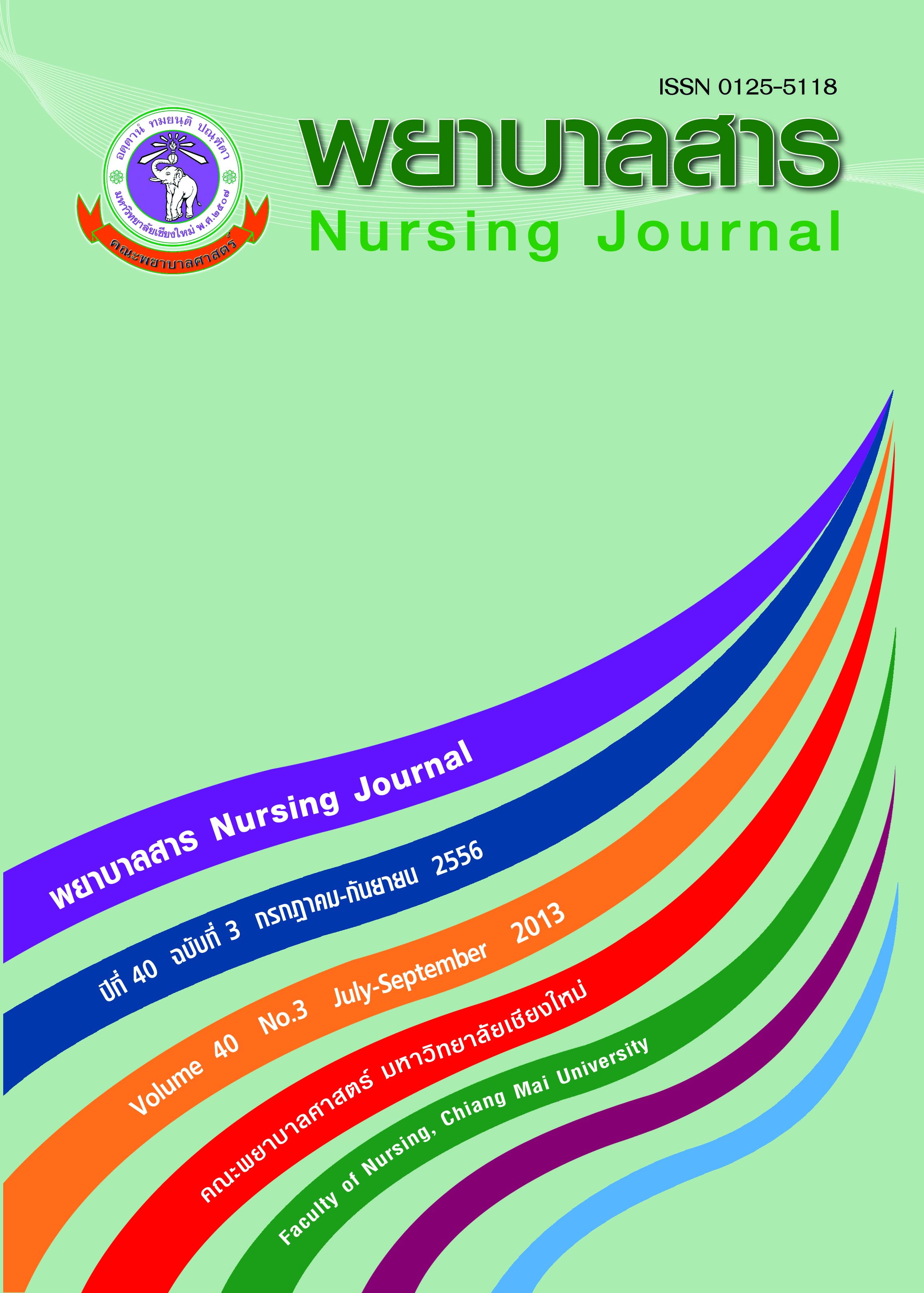การพัฒนารูปแบบการดูแลต่อเนื่องสำหรับผู้ป่วยเด็ก โรคธาลัสซีเมียและผู้ดูแล
Keywords:
รูปแบบการดูแลต่อเนื่อง, ผู้ป่วยเด็กโรคธาลัสซีเมีย, ผู้ดูแล, Continuing Care Model, Child with Thalassemia, CaregiversAbstract
บทคัดย่อ
การดูแลต่อเนื่องเป็นแนวคิดการจัดการพยาบาลเพื่อให้เกิดความเชื่อมโยงของการดูแลสุขภาพ ทั้งในระยะที่เข้ารับบริการในโรงพยาบาลและภายหลังจากจำหน่าย เพื่อสร้างเสริมสุขภาพและป้องกันการเจ็บป่วยร่วมกับชุมชน การศึกษาครั้งนี้มีวัตถุประสงค์เพื่อพัฒนารูปแบบการดูแลต่อเนื่อง สำหรับผู้ป่วยเด็กโรคธาลัสซีเมียและผู้ดูแล โดยใช้กระบวนการมีส่วนร่วมของผู้มีส่วนเกี่ยวข้อง ได้แก่ ผู้ป่วยเด็กโรคธาลัสซีเมีย และผู้ดูแล 30 คู่ กลุ่มบุคลากรทางด้านสุขภาพ 10 คนและกลุ่มตัวแทนจากชุมชน 10 คน เก็บรวบรวมข้อมูลด้วยการสนทนากลุ่มและการสัมภาษณ์แบบเจาะลึก วิเคราะห์ข้อมูลด้วยการวิเคราะห์เนื้อหา ผลการวิจัยพบว่า รูปแบบการดูแลต่อเนื่องสำหรับผู้ป่วยเด็กโรคธาลัสซีเมียและผู้ดูแล ประกอบด้วย 2 ระยะ คือ ระยะที่ 1 เป็นการดูแลระยะที่เข้ารับการรักษาในโรงพยาบาล เพื่อตอบสนองความต้องการของผู้ป่วยเด็กโรคธาลัสซีเมียและผู้ดูแลประกอบด้วย การประเมนิ ปญั หาและความตอ้ งการ การใหค้ วามรู้เรื่องโรคธาลสั ซเี มยี การสอน/สาธิต ทักษะในการดูแลตนเอง และเสริมสร้างพลังอำนาจในด้านการดูแลตนเอง ระยะที่ 2 เป็นการดูแลภายหลังจำหน่ายออกจากโรงพยาบาล โดยส่งต่อข้อมูลเกี่ยวกับการวินิจฉัย การรักษา และปัญหาที่ต้องการให้ดูแลต่อ โดยผ่านการติดตามเยี่ยมบ้านร่วมกับชุมชน ทั้งนี้ผลการวิจัยสามารถนำไปใช้เป็นแนวทางในการดูแลอย่างต่อเนื่องสำหรับผู้ป่วยเด็กโรคธาลัสซีเมียและผู้ดูแล ในการส่งเสริมให้ผู้ป่วย สามารถดูแลตัวเองอย่างต่อเนื่องที่บ้าน เชื่อมโยงระหว่างหน่วยบริการสุขภาพครอบครัวและชุมชนให้เข้ามามีส่วนร่วมในทุกระยะของการดูแล
คำสำคัญ: รูปแบบการดูแลต่อเนื่อง ผู้ป่วยเด็กโรคธาลัสซีเมีย ผู้ดูแล
Abstract
Continuing care is a concept of nursing management aiming to ensure on-goinghealthcare practice both during hospitalization and after discharge from hospital, in order topromote health and prevent illnesses with community involvement. . The main objective ofthis research study was to improve a continuing care model in a child with thalassemia andcaregivers by using participatory stakeholders approach. The target population consistedof 30 pairs of children with thalassemia and their caregivers, 10 health care providers and10 community representatives. Data were collected through group discussion and in-depthinterviews, and were analyzed by content analysis method. The study revealed that thecontinuing care model in a child with thalassemia and caregivers consisted of two phases.The first phase, hospitalization, was in response to the children’s and their caregivers’ needsand involved (i) problem and need assessment; (ii) education on thalassemia; (iii) teachingand demonstration of self-management; and (iv) building of self-empowerment. The secondphase, performed after discharge from hospital, involved (i) transfer the information aboutthe diagnosis, treatment and potential problems to the primary care unit, and (ii) home visit,so that continuing care could be provided in participation with the community. The study’sfindings could be used as a guideline to improve a continuing care model in a child withthalassemia and caregivers to properly look after themselves at home, with assistance fromhealthcare service settings, families and the community stage of caregiving.
Key words: Continuing Care Model, Child with Thalassemia, Caregivers
Downloads
How to Cite
Issue
Section
License
บทความที่ได้รับการตีพิมพ์เป็นลิขสิทธิ์ของวารสารพยาบาลสาร
ข้อความที่ปรากฏในบทความแต่ละเรื่องในวารสารวิชาการเล่มนี้เป็นความคิดเห็นส่วนตัวของผู้เขียนแต่ละท่านไม่เกี่ยวข้องกับมหาวิทยาลัยเชียงใหม่ และคณาจารย์ท่านอื่นๆในมหาวิทยาลัยฯ แต่อย่างใด ความรับผิดชอบองค์ประกอบทั้งหมดของบทความแต่ละเรื่องเป็นของผู้เขียนแต่ละท่าน หากมีความผิดพลาดใด ๆ ผู้เขียนแต่ละท่านจะรับผิดชอบบทความของตนเองแต่ผู้เดียว






